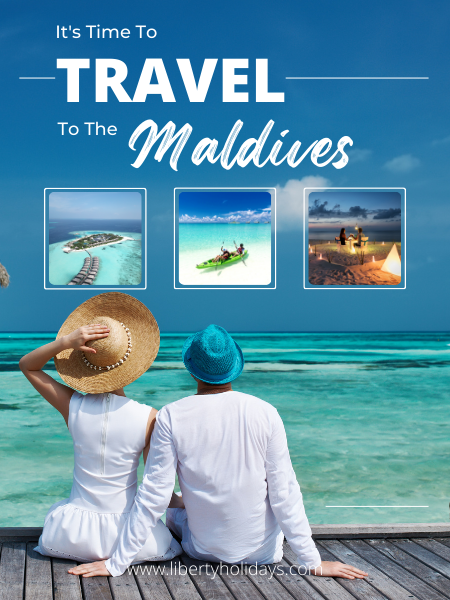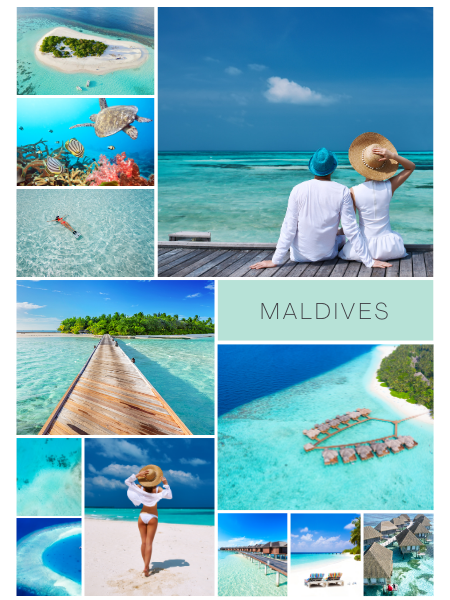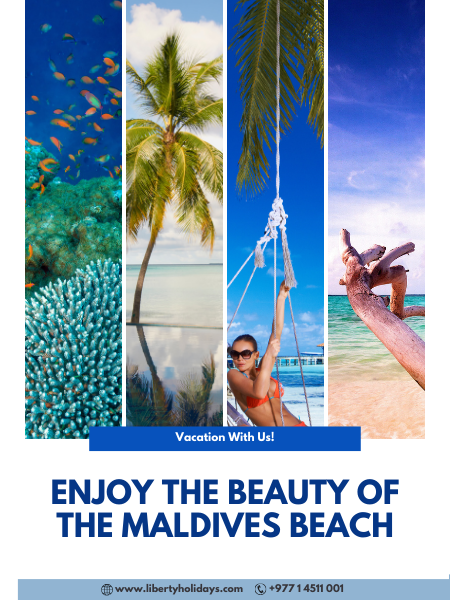Maldives
Always Natural

Maldives Travel Overview
Nestled in the heart of the Indian Ocean, the Maldives is a tropical paradise famous for its crystal-clear waters, pristine beaches, and luxurious resorts. This island nation is a dream destination for many, offering an unparalleled experience of relaxation and adventure. With its stunning natural beauty, rich marine life, and warm hospitality, the Maldives is a perfect getaway for honeymooners, families, and solo travelers alike.
Geography and Climate
The Maldives is an archipelago of 1,192 coral islands stretching across 90,000 square kilometers. The islands are low-lying, with an average height of only 1.5 meters above sea level. The Maldives has a tropical monsoon climate, with two main seasons: the dry season from December to April and the wet season from May to November. The best time to visit the Maldives is from December to April when the weather is dry and sunny.
Beaches and Water Activities
The Maldives is renowned for its stunning beaches, with powdery white sand and crystal-clear waters that are perfect for swimming, snorkeling, and diving. The islands are surrounded by coral reefs, making them a haven for marine life. The Maldives is also home to several shipwrecks, offering exciting opportunities for deep-sea diving.
Resorts and Accommodation
The Maldives is home to over 100 luxury resorts, each offering unique experiences and amenities. From overwater villas to beachfront bungalows, the resorts cater to all tastes and budgets. Many resorts offer world-class amenities, including spas, restaurants, and water sports facilities.
Wildlife and Conservation
The Maldives is a haven for marine life, with an incredible array of fish, turtles, rays, and sharks. The country is also home to several national parks and protected areas, including Hanifaru Bay, which is known for its manta ray sightings. The Maldives is committed to conservation efforts, with several initiatives in place to protect its marine life and coral reefs.
Cultural Experiences
Despite its modern infrastructure, the Maldives has a rich cultural heritage. The country has a strong Islamic tradition, with many mosques and cultural attractions. Visitors can explore the capital city of Malé, which is home to several historic landmarks, including the Grand Friday Mosque and the National Museum.
Tips and Essentials
- Best time to visit: December to April
- Language: Dhivehi (official), English (widely spoken)
- Currency: Maldivian rufiyaa (MVR)
- Visa requirements: Citizens of many countries can enter the Maldives visa-free
- Vaccinations: Recommended vaccinations include hepatitis A, typhoid, and rabies
- Health and safety: Take precautions against sunburn, heat exhaustion, and dehydration
Getting There
The Maldives has a single international airport at Malé (MLE), which receives flights from major cities around the world. You can also reach the Maldives by sea ferry or cruise ship.
Conclusion
The Maldives is a tropical paradise that offers an unparalleled experience of relaxation and adventure. With its stunning natural beauty, rich marine life, and warm hospitality, it's a perfect destination for honeymooners, families, and solo travelers alike. Whether you're looking for a romantic getaway or an action-packed vacation, the Maldives has something for everyone.

Things to Do in Maldives
The Maldives is a paradise for those seeking relaxation and adventure. With its crystal-clear waters, pristine beaches, and vibrant coral reefs, the Maldives offers a wide range of activities and experiences for visitors. Here are some of the top things to do in the Maldives:
Water Activities
- Snorkeling and Diving: Explore the Maldives' incredible marine life, including manta rays, whale sharks, and sea turtles.
- Fishing: Try your hand at catching some of the region's famous fish species, such as barracuda or tuna.
- Kitesurfing: Take advantage of the Maldives' strong winds and flat waters to experience the thrill of kitesurfing.
- Paddleboarding: Explore the islands' calm waters and coral reefs on a paddleboard.
Island Hopping
- Visit local islands: Explore the capital city of Malé, as well as other inhabited islands like Villingili and Hulhumalé.
- Beach hopping: Visit some of the Maldives' most beautiful beaches, such as Nalaguraidhoo Beach and Meeru Beach.
Wildlife Encounters
- Manta ray snorkeling: Take a guided tour to see these gentle giants up close.
- Whale shark snorkeling: Go on a snorkeling tour to see these massive fish.
- Sea turtle conservation: Visit a conservation center to learn about these incredible creatures.
Adventure Tours
- Sunset cruise: Take a romantic cruise around the atoll at sunset.
- Fishing tour: Go on a guided fishing tour to catch some of the region's famous fish species.
- Island hopping tour: Explore several islands in one day, including local markets and beaches.
Recommended Tours
- Liberty Holidays' Maldives Snorkeling Tour: Explore the Maldives' incredible marine life on a guided snorkeling tour.
- Liberty Holidays' Island Hopping Tour: Visit several islands in one day, including local markets and beaches.
- Liberty Holidays' Whale Shark Snorkeling Tour: Take a guided tour to see these massive fish up close.
Additional Tips
- Always book with reputable tour operators to ensure safety and quality.
- Be respectful of local culture and environment.
- Don't forget your sunscreen and water shoes!
The Maldives is a paradise for those seeking adventure, relaxation, and romance. With its incredible natural beauty, vibrant marine life, and warm hospitality, it's a destination that has something for everyone. Whether you're looking for an action-packed vacation or a relaxing getaway, Liberty Holidays has you covered with our range of tours and activities. Book your trip today and experience the magic of the Maldives!

Fast Facts about Maldives
The Maldives is a tropical paradise that has become a popular destination for honeymooners, families, and solo travelers alike. Here are some fast facts to help you plan your trip:
Geography and Climate
• The Maldives is an archipelago of 1,192 coral islands
• The country has a total area of approximately 90,000 square kilometers
• The Maldives has a tropical monsoon climate, with two main seasons: the dry season from December to April and the wet season from May to November
Language and Currency
• The official language is Dhivehi, but English is widely spoken
• The local currency is the Maldivian rufiyaa (MVR), although US dollars are widely accepted
Visa Requirements
• Citizens of many countries can enter the Maldives visa-free for up to 30 days
• Longer stays require a visa, which can be obtained through the Maldivian government's website
Best Time to Visit
• The best time to visit the Maldives is from December to April, when the weather is dry and sunny
• The peak season is from December to March, with prices higher during this time
Getting There
• The Maldives has a single international airport at Malé (MLE), which receives flights from major cities around the world
• You can also reach the Maldives by sea ferry or cruise ship
Resorts and Accommodation
• The Maldives has over 100 luxury resorts, each offering unique experiences and amenities
• Many resorts offer overwater villas, beachfront bungalows, and other luxurious accommodations
Safety and Security
• The Maldives is generally a safe and secure country, with low crime rates
• Take normal precautions to ensure your personal safety and security
Health and Vaccinations
• The Maldives has a high risk of mosquito-borne diseases such as dengue fever and chikungunya
• Consult your doctor before traveling to ensure you have the necessary vaccinations and medications
Other Essentials
• Electricity: 230V, 50Hz
• Wi-Fi: Widely available in resorts and tourist areas
• Mobile phone: Good coverage throughout the country
The Maldives is a tropical paradise that offers an unforgettable experience for travelers. With its stunning natural beauty, rich marine life, and warm hospitality, it's a destination that has something for everyone. Whether you're looking for relaxation, adventure, or romance, the Maldives is the perfect destination.

Travel Tips for Maldives
The Maldives is a tropical paradise that requires some preparation to ensure a smooth and enjoyable trip. Here are some valuable travel tips to help you make the most of your trip:
Packing Essentials
• Lightweight and breathable clothing
• Swimwear
• Comfortable shoes
• Sun protection (sunscreen, sunglasses, hat)
• Insect repellent
• Water bottle
• Power adapter (230V, 50Hz)
Visa Requirements
• Check if you need a visa to enter the Maldives
• Apply for a visa in advance if necessary
• Ensure your passport has at least six months' validity
Best Time to Visit
• The dry season from December to April is the best time to visit
• Avoid the wet season from May to November if possible
Getting There
• Book your flights and accommodation in advance
• Consider flying into Malé International Airport (MLE) instead of a nearby airport
• Research transportation options from the airport to your resort
Resort Life
• Research your resort's policies and amenities before arrival
• Check-in early to get settled in your villa or room
• Take advantage of resort activities and amenities, such as snorkeling, diving, and spa treatments
Marine Life
• Respect the marine life and coral reefs
• Avoid touching or standing on coral reefs
• Don't feed or touch marine animals
Safety and Security
• Be mindful of your belongings and keep valuables secure
• Avoid walking alone at night or in isolated areas
• Keep an eye on your children and pets
Health and Wellness
• Consult your doctor before traveling to ensure you're healthy enough for travel
• Take necessary medications and vaccinations
• Drink plenty of water and avoid dehydration
Communication
• Check with your phone provider for international roaming options
• Consider purchasing a local SIM card or renting a mobile phone
• Download necessary apps and software for communication and navigation
Culture
• Respect local culture and customs
• Dress modestly when visiting local islands or mosques
• Learn basic Dhivehi phrases and gestures to show appreciation
Currency
• The Maldivian rufiyaa (MVR) is the local currency
• Many resorts accept US dollars, but it's still a good idea to have some local currency for small purchases
Last-Minute Tips
• Check the weather forecast before traveling
• Pack a portable charger for your devices
• Leave a copy of your itinerary with family or friends back home
By following these travel tips, you'll be well-prepared for an unforgettable trip to the Maldives. Remember to always prioritize your safety, respect local culture, and enjoy the incredible beauty of this tropical paradise!


